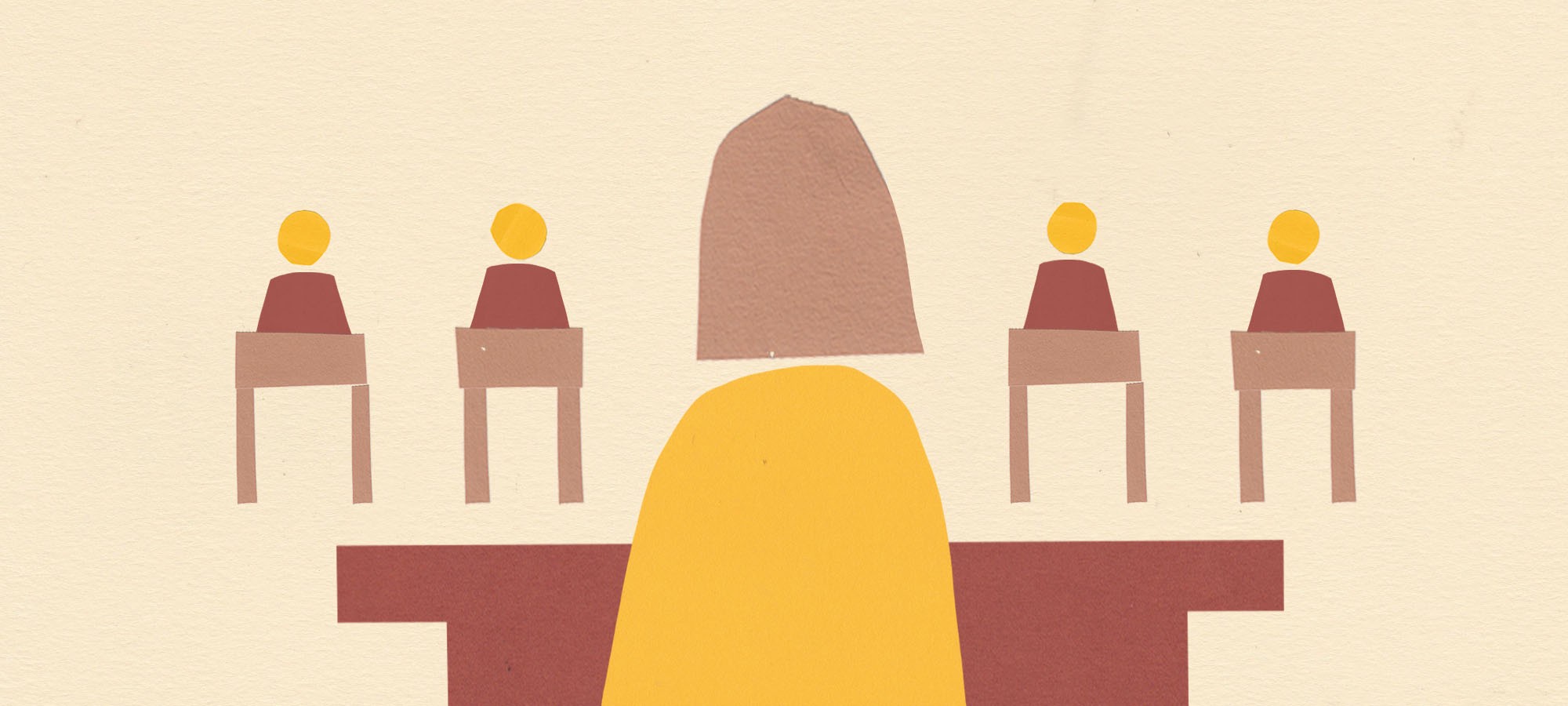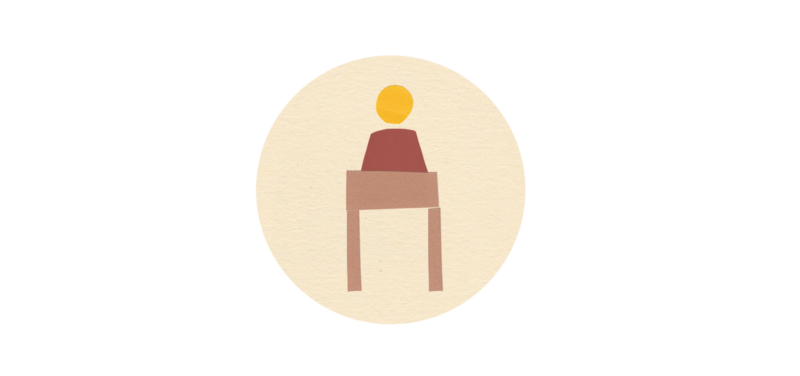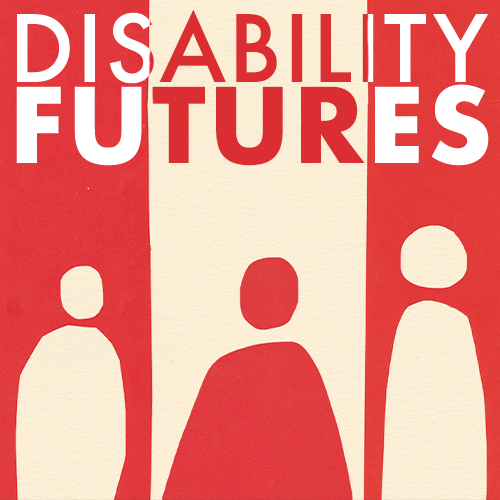

Read the next installment: “Creating Shared Spaces With Every Form of Language”
Read the previous installment: “How We Think About the Future of Disability”

Two weeks into my summer writing course, I stare down a class of rowdy college students. I’ve positioned my guide dog beneath the teacher’s desk. I hold a stack of handouts and wait for silence.
I don’t mind waiting. I can outlast their chatter until the students become unnerved by my wordlessness. I won’t shout over them. I’ll stand here, tap my foot, grin at the decorous few in the front row. Eventually they will all stop talking to one another, and the lesson can begin.
After a few seconds of undiminished conversation, my nascent plan is broken by a huge voice: “Hey! Quiet down! Can’t you see she’s ready to start?”
Abashed, the students shuffle into silence, some muttering apologies. “Sorry, man. Sorry, professor.”
I smile at the student sitting in the leftmost seat of the second row–he’s a dad, a former Navy SEAL. “Thank you, Keith.”
He grins back. “Thought you could use a little help.”
Keith’s booming tone impresses me. But I push his voice aside as I consider several different replies. I want to say, “Thanks but no thanks, I could’ve handled it myself,” or “I really didn’t mind waiting.” Or even, “You’re a sighted man and I’m a blind woman–and you’re older than me. Students will see you as the natural authority.” Despite these ready-made responses, I let the moment go.
This early in the term, I worry that my students may see Keith’s assistance as a kind of rescue: Good thing Keith used his big voice because our teacher can’t manage her students.
My anxiety is confirmed when Mary, a student in her mid-40s, shares her concerns during office hours. She says, “Sometimes my classmates really upset me. They think you can’t see them, so they copy each other’s work, text, goof off.” While I appreciate her righteous anger, Mary echoes my fear: that students perceive, and make the most of, their blind professor’s limitations.
At least I can address Mary’s concerns about cellphones by describing my course policies. I don’t mind if students use digital devices to take notes or work on class assignments, but like all teachers, I mind when they’re used for anything else. But when a cellphone rings in class, Though I have some usable vision, I can’t visually identify the phone’s owner and deduct participation points–as many sighted instructors do.
So my syllabus stipulates that when a student’s personal technology disrupts the class, the entire class gets additional homework. I am not thrilled with this policy, but it beats confiscating cellphones or banning laptops. Laptops are often used by students with disabilities, and laptop bans effectively out such students; they become the only classmates typing away when everyone else relies on pen and paper.
Keith’s assistance and Mary’s concerns show that they are my allies in the classroom, but their support is hard for me to accept. I am accustomed to others pitying or undermining me, so I expect to find these unpleasant realities in the classroom. When I read students’ remarks as judgmental or condescending, I am inviting in the critics from my past who were surprised to find a blind girl doing well in school, performing in musicals, or participating in service projects.

I must fight my insecurities each time I enter a classroom and face potential slipups: writing over text on the dry-erase board, failing to recognize the student whispering in the back row, misreading the name on a student’s work, failing to see a student’s raised hand, dropping the cap to a dry-erase marker.
The dropped marker cap is particularly annoying. How will I ever see it against that ugly patterned carpet in my classroom? I’ll nudge around with my foot, hoping to reach down and retrieve it: a smooth, purposeful gesture that says, “No big deal, I can easily find things I drop.” But if my foot doesn’t brush the cap, I’ll wait until everyone has left before I get on my knees and feel around. That’s my plan: don’t let them see me wrangle with the visual world.
But several weeks into the term, I end up dropping the cap to my black marker. Before I can start to scan the ground for it, a student jumps up from her desk and retrieves it for me. “Here you go,” she says cheerfully.
“Thanks, they are really hard to spot.” I re-cap the marker, noting a palpable change in the room, a feeling of shared relief.
I return to my desk to search for a binder clip, my hand skimming back and forth over the desk surface. Another student says, “It’s to your left, beside your water bottle.”
My hand closes over the small metal clip, and I reply, “That’s an excellent use of specific direction words.”
In this moment, I recognize the shift: I am willing to accept my students’ help without qualification. Suddenly I don’t feel pressured to explain or defend the workarounds I would have used if I were on my own. I feel connected to the group I’ve been teaching.
I’ve been fighting my own expectations, pitting myself against my imagined Ideal Teacher, who never drops markers or misplaces binder clips. She looms in every classroom, the teacher whose body always works in harmony with her intentions. And her power is subtle: I can only see her as I am learning to banish her. I did not know how much my students could help me cast her out. I lament the brevity of our term together.

In our final week of class, we return from a break, and I glance around the half-empty room, checking the time on my watch. “Almost 3:15, I wonder where everyone is.”
“Did you just feel your watch?” asks Drew, a front-row student.
“Yes, it’s a braille watch.” I show him how the crystal lifts, so that I can feel the hands and the embossed dots at 3, 6, 9, and 12 o’clock. “Of course, it’s not actual braille,” I explain. “The full letters wouldn’t fit. They just use the same kind of dots.”
Drew leans forward. “How does braille work? I tried to read a sign in the hallway, but I didn’t get it at all.”
As my late students take their seats, I start drawing a braille cell on the board. I label the six dots and describe how different patterns make each letter. Halfway through my demonstration, I realize that I’m talking disability stuff. Normally I avoid these conversations in class because they make me feel like an exhibit at the Blindness Museum.
And discussing the specifics of my blindness takes us a little too close to the popular link between blindness and ineptitude. Too often people observe a blind person performing an everyday task–pouring a coffee, paying for groceries, walking up the stairs–and ask, “How can she possibly do that?” Because we generally don’t see competent disabled people in the media, most people cannot imagine how I navigate the visual challenges of my life. People say, “You dress so well for a blind woman,” or “You walk so confidently–I had no idea you were blind!”
In the same way that students enter my class with personal histories of reading and writing, I begin as their teacher with an internalized litany of others’ low expectations. When I face a visual task in the classroom, I hear the potential questions: “Is she really qualified to teach?” “How will she manage?” Each struggle with some visual aspect of teaching becomes a chink in my credibility. All my energies are then diverted to defend my worth as a young blind instructor.
This is an old battle that I have carried through the door. When I avoid discussing disability issues in class, I am telling my students that these discussions should be avoided. But if I fight for inclusion and equal access for my disabled students, I must extend these rights to myself. I must accept that I perform in nonstandard ways. I must be ready to talk about the strategies I have developed as a blind teacher.
These students have shown me that my nonstandard ways must live at the center of my courses. We all enter the classroom under the weight of external judgments, past and present. By honestly acknowledging my disability in the classroom, I will help students confront their own ideals–especially the ones we need to banish together.

Read the next installment: “Creating Shared Spaces With Every Form of Language”
Read the previous installment: “How We Think About the Future of Disability”

How We Get To Next was a magazine that explored the future of science, technology, and culture from 2014 to 2019. Disability Futures is a six-part series curated by Kenny Fries. We can’t think about the future–of health, of technology, of community–without centering disability.
